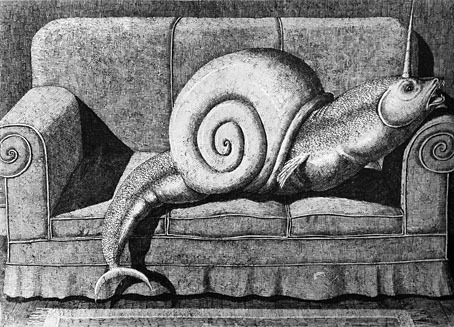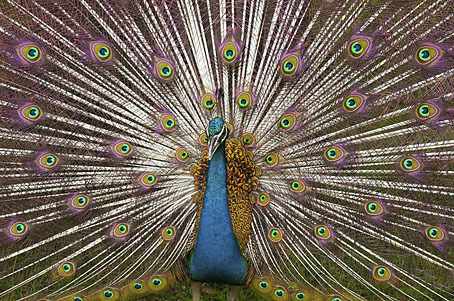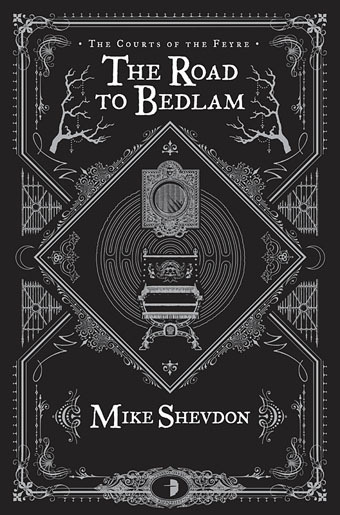John Coulthart's Blog, page 288
December 22, 2011
Gustave Doré's Ancient Mariner
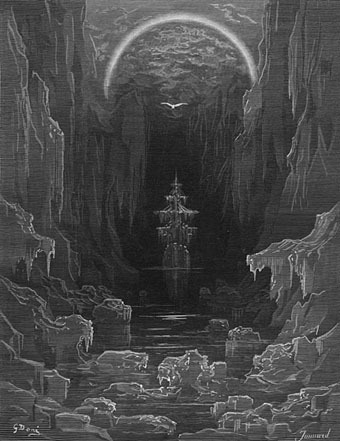
A final Coleridge post, also the oldest illustrated edition featured this week. Gustave Doré's The Rime of the Ancient Mariner was first published in 1870, and the poet's sombre, doom-laden tale was more suited to Doré's Gothic proclivities than many of the lighter books he illustrated. Despite their age, these engravings have proved memorable enough to keep turning up whenever an illustration of the poem is required. The ship among the icebergs above is close enough to a scene in the third Pirates of the Caribbean film to have maybe been an influence, while the ice-bound section of the poem inspired one of Doré's few paintings.
Art Passions has a complete set of these engravings together with many more of the artist's works. And while we're on the subject, two of Harry Clarke's surviving Ancient Mariner drawings appeared in a post last year. A third drawing from the series can be seen here.
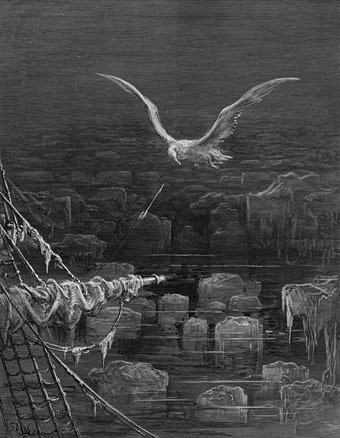
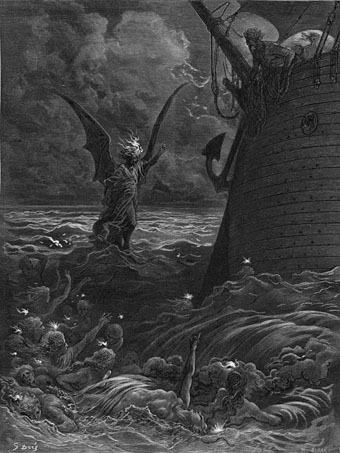


Elsewhere on { feuilleton }
• The etching and engraving archive
• The illustrators archive
Previously on { feuilleton }
• Joseph Noel Paton's Ancient Mariner
• Patten Wilson's illustrated Coleridge
• Gerald Metcalfe's illustrated Coleridge
December 21, 2011
Joseph Noel Paton's Ancient Mariner
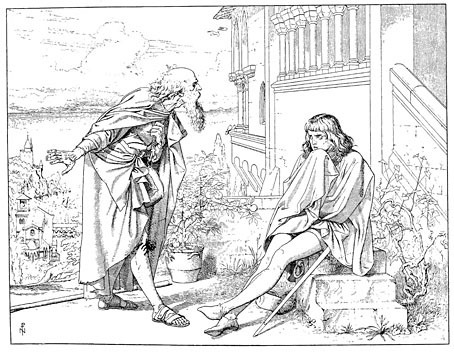
From Patten Wilson to Joseph Noel Paton (1821–1901), a Scottish artist whose illustrations for Coleridge's poem I much prefer to his generic paintings. Other artists often skimp on the ship details but Paton's crowded deck scenes are done with such accuracy they must have been based on a real vessel. The book was published in 1893, and the plates would appear to be engravings given the presence of another monogram besides that of the artist. The Internet Archive scans aren't as bad as the Patten Wilson but Paton's meticulous draughtsmanship is best seen in the near-complete set of images posted at Golden Age Comic Book Stories. And for anyone familiar with my comic strip adaptation of Lovecraft's The Haunter of the Dark, the portrait of Enoch Bowen, founder of the Starry Wisdom cult, was based on Paton's head of the Ancient Mariner in the scene where the sailors are fastening the albatross around the accursed man's neck.


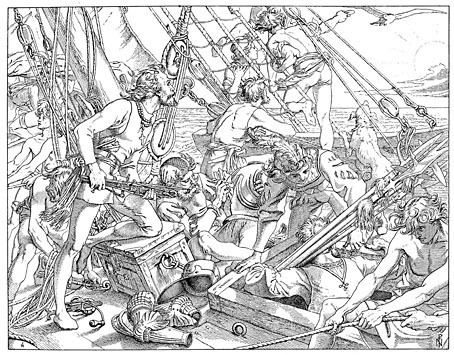
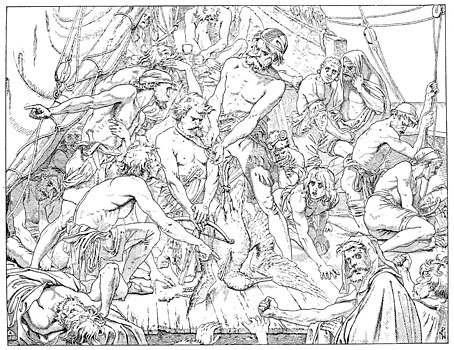
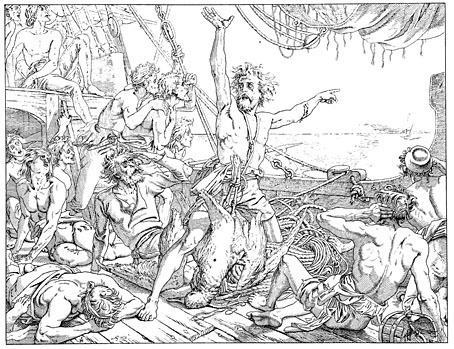
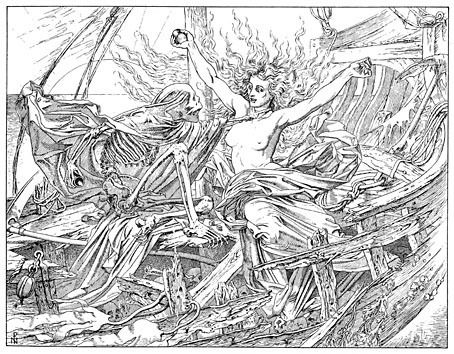
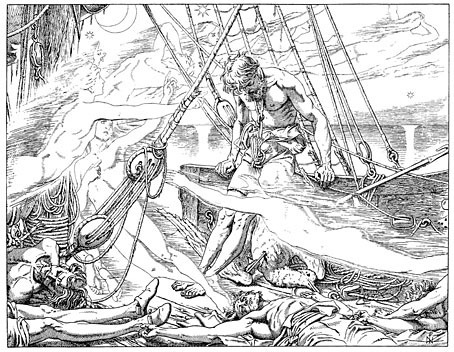

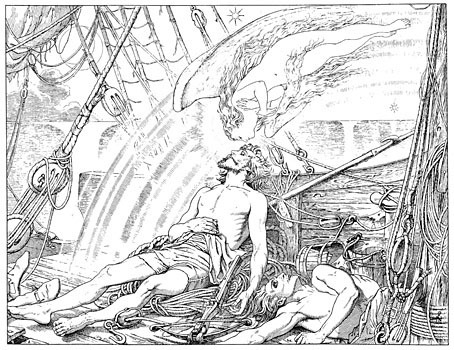

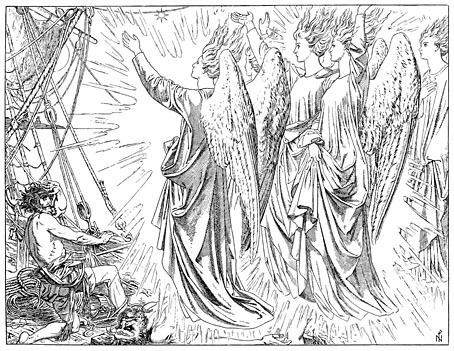
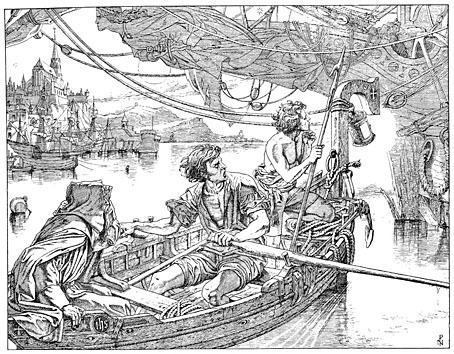

Elsewhere on { feuilleton }
• The illustrators archive
Previously on { feuilleton }
• Patten Wilson's illustrated Coleridge
• Gerald Metcalfe's illustrated Coleridge
December 20, 2011
Patten Wilson's illustrated Coleridge

As is evident by the blurred date on the title page, this illustrated Coleridge by Patten Wilson (1868–1928) was published in 1898. Once again, some of these drawings have appeared here before via copies at Chris Mullen's Visual Telling of Stories where the scans are a lot better quality than the dreadful job done by Google at the Internet Archive. The drawings look passable when reduced in size but the full-size images are so aggressively compressed that much of Wilson's fine detail is lost. There's still very little of Wilson's beautiful work to be found online—and Coleridge's poetry is freely available everywhere—so the only reason to look at this particular edition is for the illustrations.
As with Gerald Metcalfe's volume, The Rime of the Ancient Mariner dominates the collection. I love the way Wilson renders the opening scene by placing the Mariner and the wedding guests in the corner of the picture so he can prefigure the tale with the boats waiting in the harbour. And Kubla Khan's Pleasure Dome is a lot more impressive than Metcalfe's city in the clouds. Here's hoping that a better copy turns up eventually.
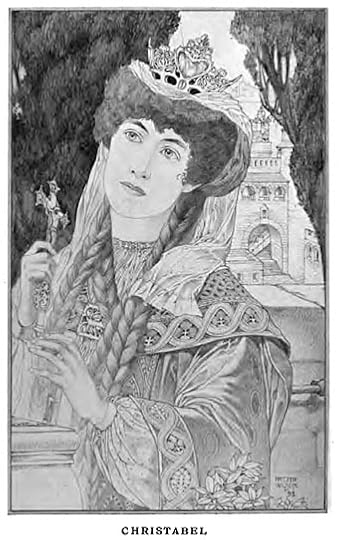
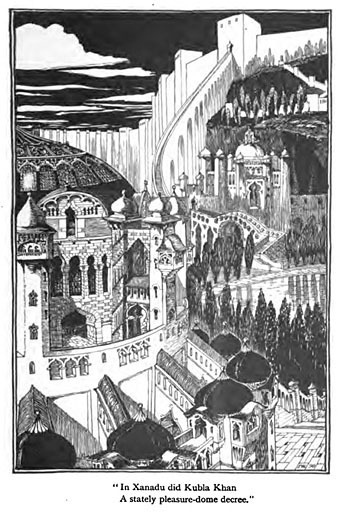
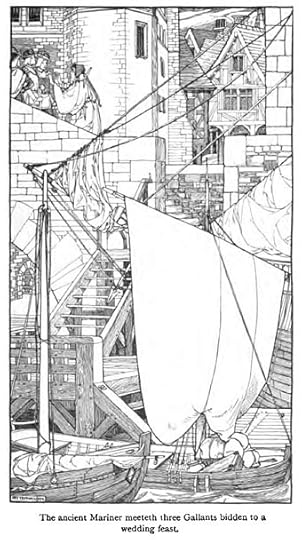

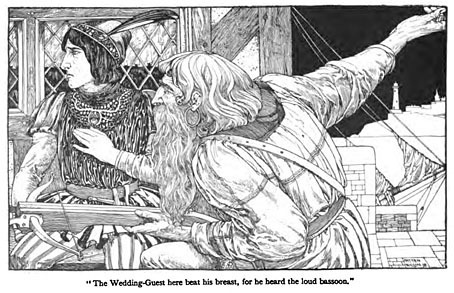
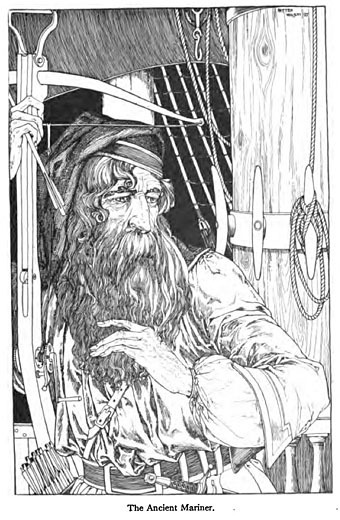
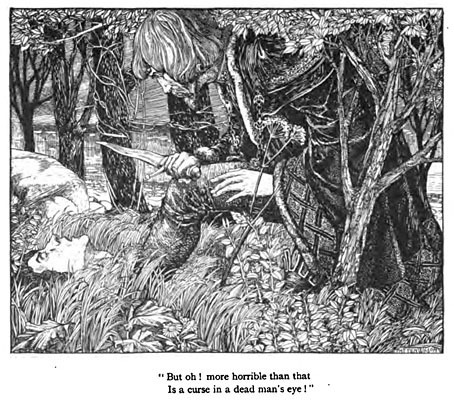
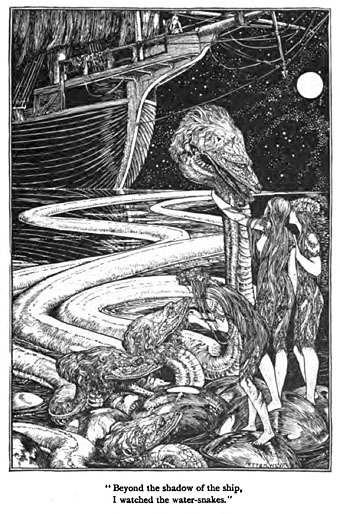
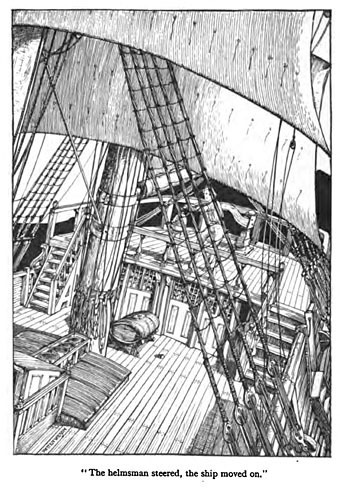

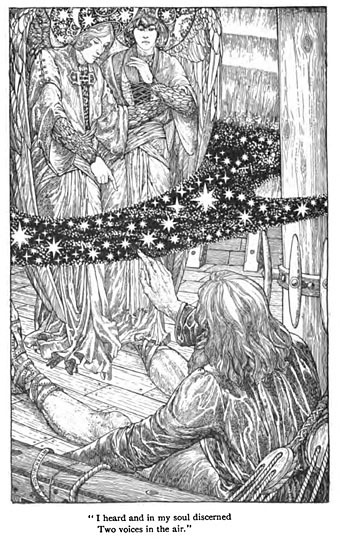

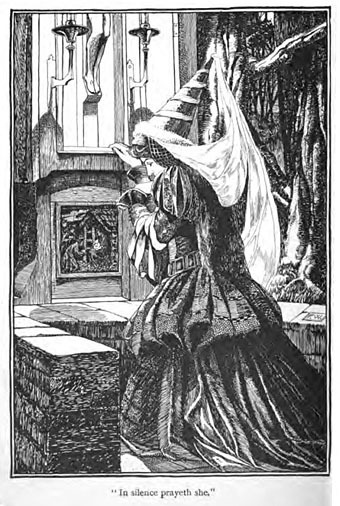
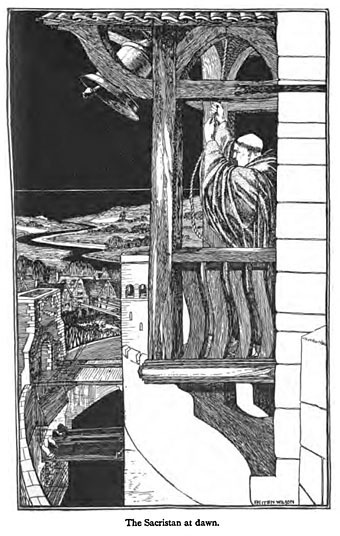

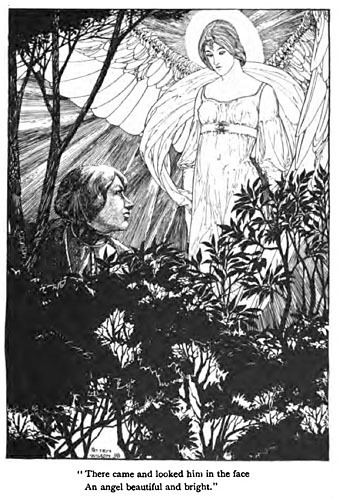
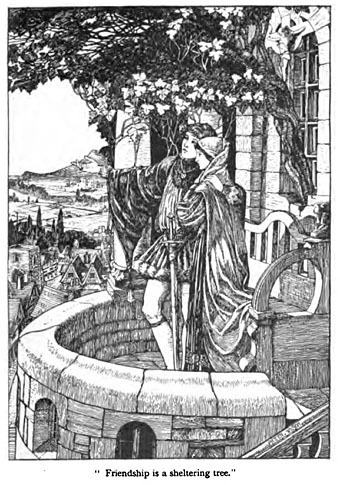

Elsewhere on { feuilleton }
• The illustrators archive
December 19, 2011
Gerald Metcalfe's illustrated Coleridge
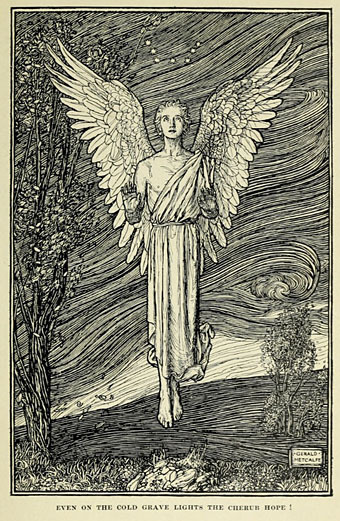
This angel figure appeared here just over a year ago in a selection from Modern Book Illustrators and Their Work (1914). Subsequent searching at the Internet Archive turned up a well-used copy of The Poems of Coleridge (1907) from which the drawing originates. Gerald Metcalfe (1894–1929), was a British artist whose ink renderings often resemble woodcut engravings. Some of the drawings seem a little perfunctory but he does a decent enough job with The Rime of the Ancient Mariner, a poem whose wealth of incident is more suited to illustration than many of Coleridge's shorter pieces.
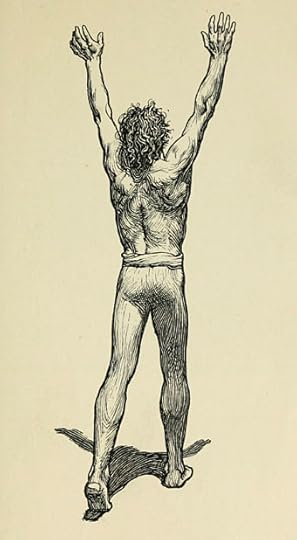
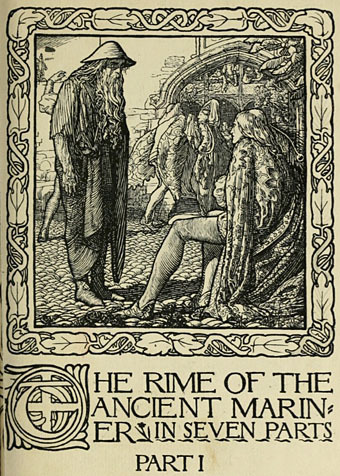

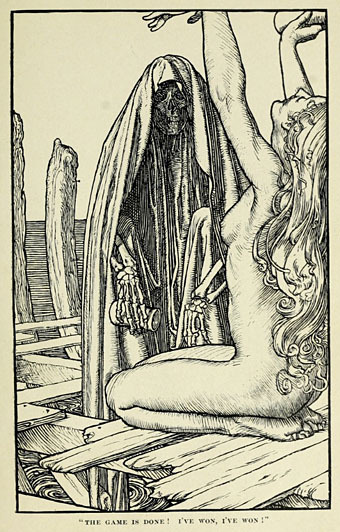
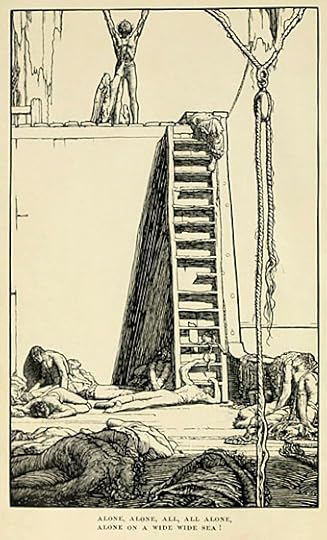
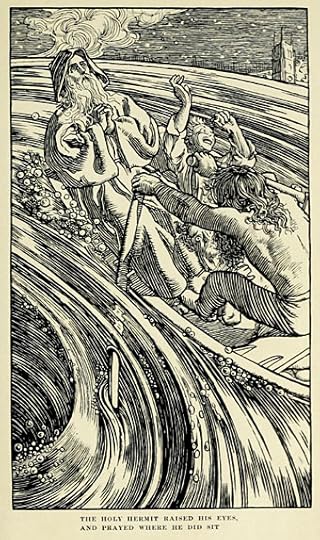

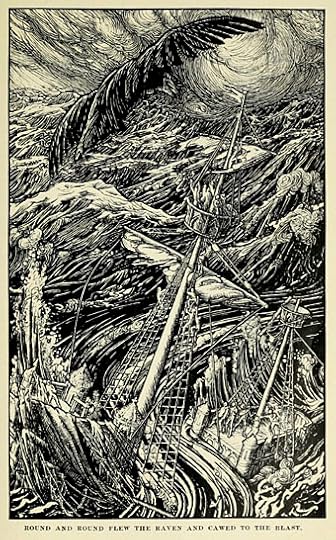

Elsewhere on { feuilleton }
• The illustrators archive
December 18, 2011
Colour photography, 1908
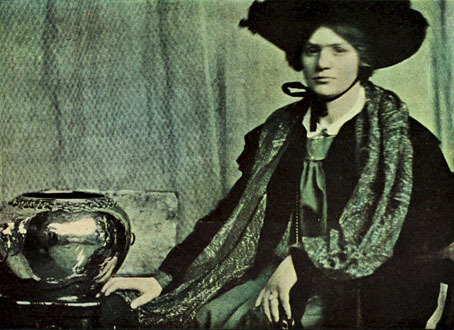
Portrait of Jessie M. King by J. Craig Annan (autochrome).
I don't recall having seen a photo of artist Jessie M. King prior to this so it's an additional surprise to find one in colour. All these examples are from Colour Photography: and other recent developments of the art of the camera (1908), one of the many books editied by Charles Holme from features in The Studio magazine. Needless to say, not all the entries are colour but a number of the monochrome plates have their own qualities, such as that painterly effect which so many early photographers were eager to cultivate. Anyone familiar with Gertrude Käsebier's very painterly The Crystal Gazer, famous for its appearance on the cover of a Cocteau Twins sleeve, may like to know that two more portraits by Ms Käsebier are included in Holme's selection. For a look at more recent attempts to match the effects of painting with the camera, see this piece by Rick Poynor about the remarkable work of Saul Leiter.

A Tangle After a Storm by Walter Bennington.
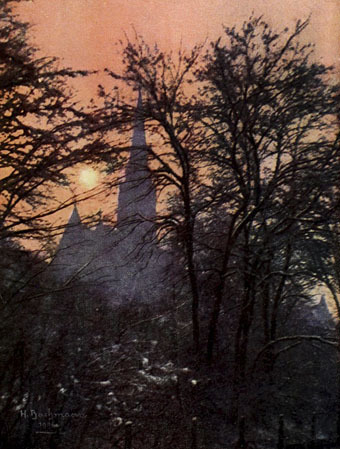
A Late Winter Sun by Dr. H. Bachmann (gum print).
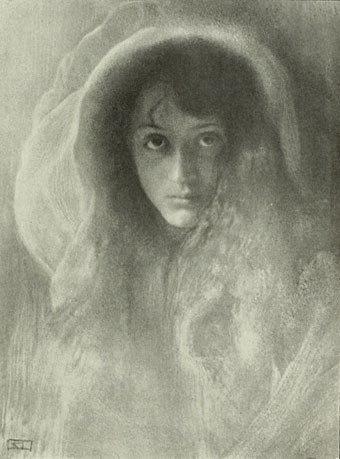
Louise by Robert Demachy.

Study of a Head by Siri Fischer-Schneevoigt.
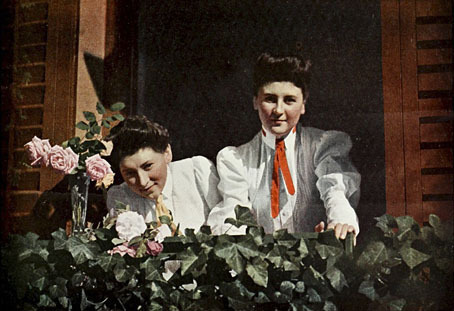
The Sisters by Frank Eugene (autochrome).
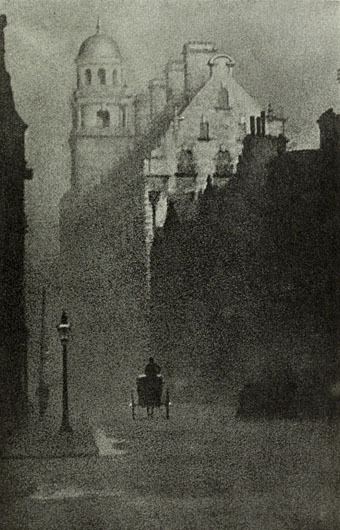
Liverpool — An Impression by J. Dudley Johnston.
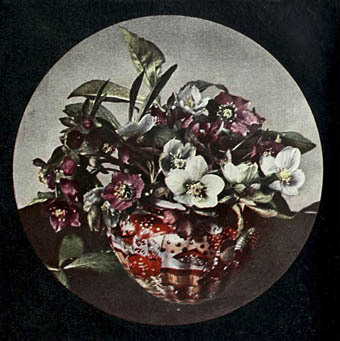
Christmas Roses by F. W. Urquhart (autochrome).

The Thames by E. Warner (oil print).
Previously on { feuilleton }
• Fred Holland Day revisited
• Constantinople, 1900
• Albert Kahn's Autochromes
• Gertrude Käsebier's crystal gazer
• The Dawn of the Autochrome
December 17, 2011
Weekend links
A drawing from Bestiario Moderno by Domenico Gnoli (1933–1970).
RIP Russell Hoban. Nina Allan celebrates a favourite writer while David Mitchell, writing in 2005, pays tribute to Riddley Walker. For me the gulf between Hoban and many of his contemporaries could be measured by his entry in the Writer's Rooms feature the Guardian Review was running for a couple of years: Hoban's room was the only one that admitted to being cramped and chaotic.
A wristwatch could be "a tiny flowering hell, a wreath of roses, a dungeon of air" and still tell time. A short story could take the shape of an instruction manual for the most routine of tasks (crying, singing, winding said dungeon, killing ants in Rome), or a compendium of tales about fantastical but oddly familiar species. A novel didn't have to progress from the first page to the last, hung on a rigid skeleton of plot: it could proceed in oblong leaps and great steps backward, like a game, say, of hopscotch. "Literature is a form of play," said Cortázar. [...] It is perhaps because he so stubbornly resists categorization, as much as for the ludic complexity of his work, that Cortázar is in these parts more admired than he is read. The Anglophone literary imagination (or perhaps just its material substrate: the market) appears to have room for only one Latin American giant per generation—Borges, García Márquez, the freshly beatified San Bolaño. Cortázar was too weird, too difficult, too joyously slippery to make the cut.
Eels Über Alles: Ben Ehrenreich on Julio Cortázar
• Alfred Jarry is another writer the Anglophone world has often found "too weird, too difficult". Jarry has been dead for over a century but Alastair Brotchie's recently-published full-length biography is the first such work in English. Mark Polizzotti reviews a life of "the poster boy for literary cult figures" at Bookforum.
• "A Beautiful Trip": Frances Morgan interviews David Lynch about music and sound. And Robert Wyatt talks for 95 minutes to Tony Herrington about his favourite music.
• Twilight Science: Paul Schütze presents solo musical work and various collaborative projects in new digital editions.

Jonathan Barnbrook's logo design for Occupy London.
• Winter reads: Myths of the Norsemen by Roger Lancelyn Green. Related: What became of illustrations in fiction?
• The White People and Other Weird Stories by Arthur Machen is a new Penguin Classic out in January.
• "This Christmas, why not give Viriconium, city of sex, syphillis & consubstantiation?"
• The Casual Optimist announces its Favourite Book Covers of 2011.
• Function (2011) by Emptyset | Aftertime (2011) by Roly Porter with Cynthia Miller on the Ondes Martenot.
December 16, 2011
The Weird Questionnaire
A peacock. Photograph by Vidhya Narayanan.
Posted at the Weird Fiction Review in the past week, The Weird (or Étrange) Questionnaire is Éric Poindron's Weird (or Étrange) riposte to the Proust Questionnaire. I'd read the post, and seen Jeff VanderMeer's answers to the questions, but wasn't planning on answering it myself until Neddal Ayad wrote asking whether I'd be willing to do so for a future WFR assembly of responses. So here we are. The rules are as follows:
…there are sixty questions (twice as many as most versions of the Proust Questionnaire). Spend no more than a minute on each, and an hour in total. However, don't keep checking your watch: "let writing define time."
In the end I took longer than an hour, but the time limit is a good idea otherwise I'd have spent far too long pondering, revising, qualifying remarks, unqualifying the qualifications, and so on. Deadlines have their uses.
The Weird Questionnaire
1: Write the first sentence of a novel, short story, or book of the weird yet to be written.
The first night of winter moonlight revealed a pattern of tiny runic figures etched inside the window glass.
2: Without looking at your watch: what time is it?
01:15
3: Look at your watch. What time is it?
01:20
4: How do you explain this—or these—discrepancy(ies) in time?
It's always later than you think.
5: Do you believe in meteorological predictions?
"Believe" seems the wrong word in this context since the question concerns a conjecture based on scientific study. Short-range forecasts are fine, long-range ones seldom seem to be.
6: Do you believe in astrological predictions?
If this refers to newspaper columns, they're always so vague they may as well be computer-generated. Maybe they are.
7: Do you gaze at the sky and stars by night?
Yes, when I'm out of the city.
8: What do you think of the sky and stars by night?
My bad eyesight (the stars are always a blur), the length of time the light has taken to reach us, how the familiarity of the few stars we do manage to see shields us from the true immensity of the stellar gulfs.
9: What were you looking at before starting this questionnaire?
A guest post by Clive Hicks-Jenkins on Kathe Koja's blog.
10: What do cathedrals, churches, mosques, shrines, synagogues, and other religious monuments inspire in you?
Further appreciation of the values of art, architecture and related crafts. In the case of cathedrals: astonishment at the feats of labour required to build them in a pre-industrial age; their presence as sites of accumulated history.
11: What would you have "seen" if you'd been blind?
The gold of the tigers.
12: What would you want to see if you were blind?
One of my eyes has never functioned properly which means I don't have stereoscopic vision, can't see 3D films or 3D pictures of any kind, etc. I don't miss something I've never experienced so if I'd been born blind I might feel the same about the condition.
13: Are you afraid?
Sometimes.
14: What of?
The usual stuff, mostly the premature death or possible suffering of loved ones.
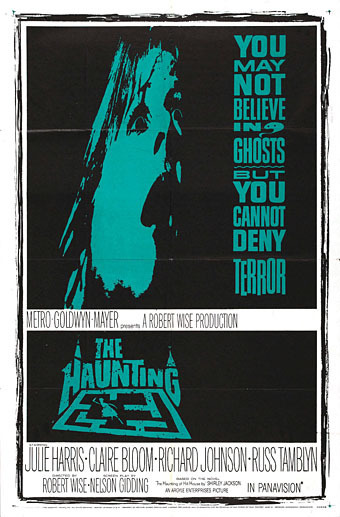
15: What is the last weird film you've seen?
For Halloween I re-watched the Robert Wise film of The Haunting.
16: Whom are you afraid of?
Fundamentalists of any creed or nationality.
17: Have you ever been lost?
Yes, in London once or twice, and once here in Manchester when I got on the wrong bus in the evening, realised I didn't know where I was then got off in a completely unknown area of the city. It was a strange experience being only a few miles from very familiar streets but with no idea which way to turn. I got home by calling a cab.
18: Do you believe in ghosts?
"Believe" is a word I distrust, not least because belief is the province of the fundamentalist. I'm generally agnostic about things that can't be explained. I've always been interested in paranormal matters whilst being equally interested in hard science. The agnostic impulse makes me impatient both with the clichés of paranormal studies and the routine dismissal by science of anomalies that won't fit the current view of things. This answer shows I'll risk pomposity rather than simply say "yes" or "no".
19: What is a ghost?
A ghost is a loaded term, unfortunately, like "UFO", one of those clichés that bring a mass of unwanted baggage to any discussion.
20: At this very moment, what sound(s) can you here, apart from the computer?
A track from The Plateaux of Mirror by Brian Eno and Harold Budd.
21: What is the most terrifying sound you've ever heard: for example, "the night was like the cry of a wolf"?
For some reason I find enormously loud klaxon sounds very disturbing: foghorns or particular kinds of sirens or alarms. I'm thinking of the grating alert that sounds when a sluice-gate opens in The Parallax View and Warren Beatty's character nearly gets killed. It's as much the implication behind the sound as the sound itself, a warning to flee or suffer the consequences, the sense that vast actions are in progress which may destroy us.
22: Have you done something weird today or in the last few days?
Not particularly.
23: Have you ever been to confession?
Yes, I was ineffectively raised as a Catholic.
24: You're at confession, so confess the unspeakable.
The Pope is gay.
25: Without cheating: what is a "cabinet of curiosities"?
A repository of the inexplicable, prodigious or uncategorised.
26: Do you believe in redemption?
In a religious sense, no; in other senses, sometimes.
27: Have you dreamed tonight?
I'm sure I did but I don't recall it.
28: Do you remember your dreams?
Sometimes.
29: What was your last dream?
Something about two boys meeting each other. "I bet they're going to kiss," predicted my omniscient and disembodied self. They did.
30: What does fog make you think of?
The way a slight change of circumstances alters our perceptions.
31: Do you believe in animals that don't exist?
Books are full of them.

32: What do you see on the walls of the room where you are?
A large cinema poster for Werner Herzog's Nosferatu the Vampyre.
33: If you became a magician, what would be the first thing you'd do?
Restore the original ending of Orson Welles' The Magnificent Ambersons.
34: What is a madman?
The psychiatric Other.
35: Are you mad?
No, but I have been labelled as such.
36: Do you believe in the existence of secret societies?
Yes, I have a nice book by Arkon Daraul on the subject.
37: What was the last weird book you read?
The Wine-Dark Sea by Robert Aickman.
38: Would you like to live in a castle?
No, they're cheerless, draughty and impossible to heat.
39: Have you seen something weird today?
No.
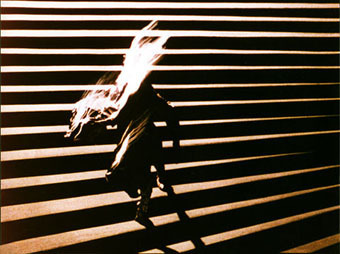
40: What is the weirdest film you've ever seen?
41: Would you like to live in an abandoned train station?
Yes.
42: Can you see the future?
I've had enough very striking precognitive dreams to regard them as being more than confirmation bias. How they work is a question for science.
43: Have you considered living abroad?
Yes.
44: Where?
In America and in France.
45: Why?
Familiarity breeds contempt.
46: What is the weirdest film you've ever owned?
L'Ange by Patrick Bokanowski.
47: Would you liked to have lived in a vicarage?
Yes, if it wasn't too far from civilisation (ie: a city).
48: What is the weirdest book you've ever read?
Finnegans Wake.
49: Which do you like better, globes or hourglasses?
Globes.
50: Which do you like better, antique magnifying glasses or bladed weapons?
Antique magnifying glasses.
51: What, in all likelihood, lies in the depths of Loch Ness?
The crushed dreams of generations of Nessie hunters.
52: Do you like taxidermied animals?
I like the ones in our local museum since they're Victorian creations that include a tiger frozen in the act of leaping. Also a genuine dodo.
53: Do you like walking in the rain?
Yes, if I have an umbrella and waterproof shoes.
54: What goes on in tunnels?
What happens in the tunnels stays in the tunnels.
55: What do you look at when you look away from this questionnaire?
The aforementioned Werner Herzog poster.
56: What does this famous line inspire in you: "And when he had crossed the bridge, the phantoms came to meet him."?
Phantom is a word that for me brings to mind that silly costumed comic-book hero. So the first thought was of a crowd of such figures meeting somebody.
57: Without cheating: where is that famous line from?
I've no idea.
58: Do you like walking in graveyards or the woods by night?
I like walking in graveyards at any time. Woods at night are treacherous places.
58: Write the last line of a novel, short story, or book of the weird yet to be written.
"The peacocks are never what they seem," she said.
59: Without looking at your watch: what time is it?
02:40
60: Look at your watch. What time is it?
02:52
Previously on { feuilleton }
• Edward Gorey book covers
• Weird Fiction Review
December 15, 2011
Athanasius Kircher's Tower of Babel
Here's a picture whose myriad details I've wanted to scrutinise for many years. Lieven Cruyl was the draughtsman and Coenraet Decker the etcher while the picture itself appears as an illustration in Athanasius Kircher's (deep breath) Turris Babel, Sive Archontologia Qua Primo Priscorum post diluvium hominum vita, mores rerumque gestarum magnitudo, Secundo Turris fabrica civitatumque exstructio, confusio linguarum, & inde gentium transmigrationis, cum principalium inde enatorum idiomatum historia, multiplici eruditione describuntur & explicantur. The book was published in 1679 and, among other speculations, features Kircher's eye-popping illustration (below) showing how tall the Tower of Babel would have to be in order to reach the Moon. I used part of the big illustration in a cover design for metal band Melechesh in 2006.

The copies here are from a scanned volume at the University of Heidelberg where the pages have suffered slightly from bookworm but the resolution is high enough to explore a picture crawling with tiny details, from the bristling scaffolding at the top of the structure, and the houses (for the workers?) built on the ramps lower down, to a procession of camels and other beasts being led towards the main entrance. In the background there are smaller towers and a few pyramids (Kircher explored the latter in elsewhere in the book), and also a harbour with beast-headed sailing ships. The full-size picture may be explored here.
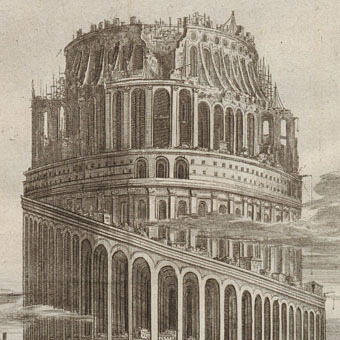
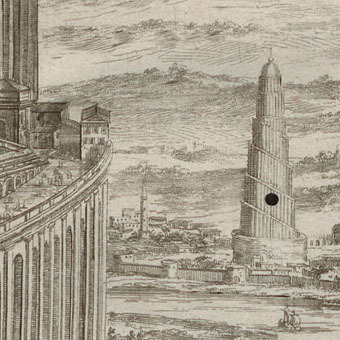
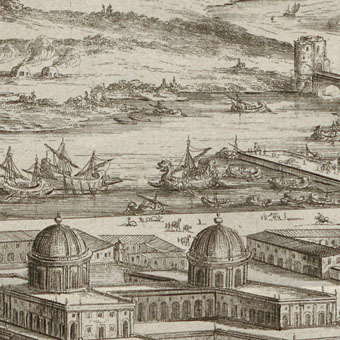
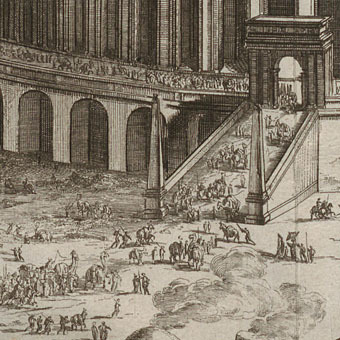
Elsewhere on { feuilleton }
• The etching and engraving art archive
Previously on { feuilleton }
• La Tour by Schuiten & Peeters
December 14, 2011
The Courts of the Feyre
Three new cover designs of mine for Angry Robot which were made public a few hours ago. The Courts of the Feyre is a fantasy series by British author Mike Shevdon set in present-day Britain and involving "a world of dark magic and strange creatures hidden in plain sight." Two of these titles are reprints, Strangeness and Charm is a new addition to the series, and there are plans for a fourth title later on.
Marc at Angry Robot wanted a distinctive, uniform look for the series, and I'm very pleased with the way the designs turned out. Since the plan was to use a decorative frame printed on black I decided to have a tilted square in the centre of each cover to make a shape that would catch the eye on a shelf or when seen as a thumbnail image. It's also possible to interpret the squares as a kind of "court" within each design, with each court containing articles relevant to that story.
All three books are due to be published in June 2012.
Elsewhere on {feuilleton }
• The book covers archive
Previously on {feuilleton }
• Steampunk overloaded!
December 13, 2011
Tom Phillips album covers
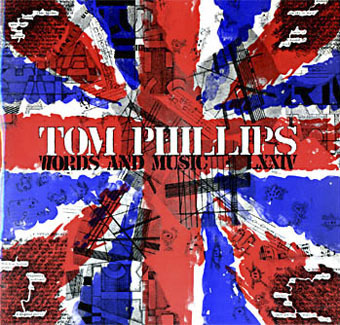
Words and Music (1975) by Tom Phillips.
Two related posts is coincidence, three is a series. Earlier posts from the past couple of weeks looked at album covers created by designers better known for their work in other areas. Tom Phillips is a British artist, writer and composer who I continue to insist is one of our greatest living artists, a figure of singular intelligence, invention and versatility whose lack of grandstanding has never raised his profile to, say, the Hockney level. Phillips' involvement with the music world, both as composer/librettist, and his oft-cited position as Brian Eno's art teacher in the 1960s, have led to the creation of a handful of record and CD covers from the mid-70s on. Before we get onto those I'll note that Phillips has a piece in the latest edition of Eye magazine where he reviews a book of postcards from the Wiener Werkstätte. I happen to have a review in the same issue looking at a republished Kenneth Anger study.
Words and Music above has a January 1975 release date although the cover clearly states "LXXIV" in Phillips' customary stencil lettering. The pressing was limited to 500 copies and doesn't seem to have been reissued since which means that copies for sale command excessive prices. Side A comprises recordings of Phillips' compositions while on the flip the artist/author reads extracts from A Humument, the treated book/experimental novel which is not only his most celebrated work but a project whose influence permeates all of the Phillips oeuvre, including the sleeve art.

Starless and Bible Black (1974) by King Crimson.

A year before Words and Music, Phillips created the cover art for this King Crimson album, and he's also credited with the design. The fractured stencil lettering on the gatefold interior resembles similar effects in some of Phillips' paintings while on the back cover there's a tiny extract from A Humument bearing the enigmatic phrase "this night wounds time". I've wondered for years how this cover came about: Robert Fripp often selects the art for King Crimson's covers so was Phillips his choice as artist/designer? Or was it a result of the Fripp and Eno connection? If anyone knows the answer, please leave a comment.
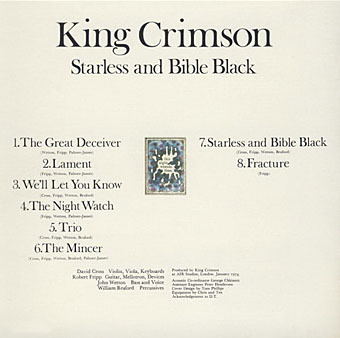
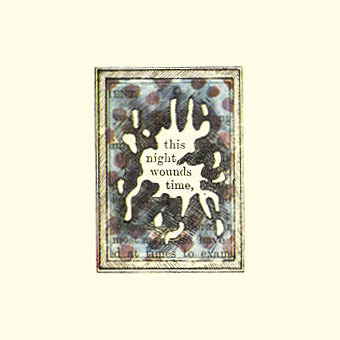
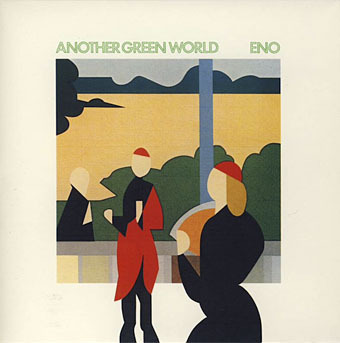
Another Green World (1975) by Brian Eno.
And speaking of Eno, the painting on Another Green World is probably the most visible example of Phillips sleeve art, a detail from After Raphael (below). Phillips explains the genesis of the original work here.
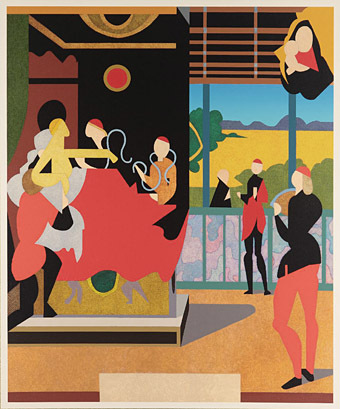
After Raphael (1972) by Tom Phillips.

Thursday Afternoon (1985) by Brian Eno. Painting by Tom Phillips, design by Russell Mills.
An abstract watercolour miniature fills out the CD insert for one of Eno's finest albums.
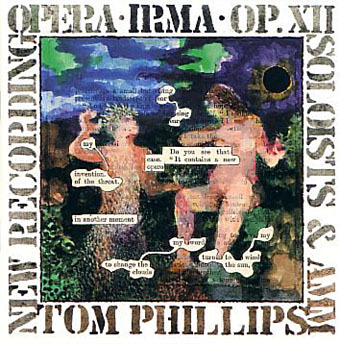
IRMA (1988) by AMM & Tom Phillips.
IRMA is the opera Phillips composed in 1969 with a libretto created via extracts from A Humument. The first recording appeared on Eno's Obscure label in 1978 where it had one of the collage sleeves designed by John Bonis for most of the records in that series. In his book Works and Texts (1992) Phillips expresses dissatisfaction with the way the composition was credited to arranger Gavin Bryars with "libretto by Fred Orton". The new recording by AMM featured John Tilbury who played on Words and Music, and is a lot closer to Phillips' original intention. Despite Phillips' reservations I quite like the Obscure version which you can hear for yourself at Ubuweb.
Elsewhere on { feuilleton }
• The album covers archive
Previously on { feuilleton }
• Thursday Afternoon by Brian Eno
• A TV Dante by Tom Phillips and Peter Greenaway
• 20 Sites n Years revisited
• 20 Sites n Years by Tom Phillips
John Coulthart's Blog
- John Coulthart's profile
- 31 followers


